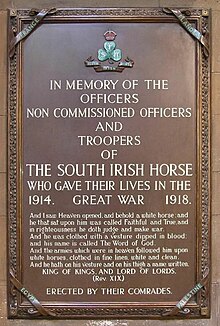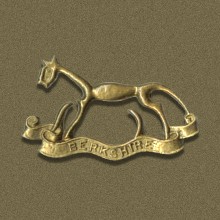
The Berkshire Yeomanry was a part time regiment of the British Army formed in 1794 to counter the threat of invasion during the French Revolutionary Wars. It was the Royal County of Berkshire's senior volunteer unit with over 200 years of voluntary military service. After taking part in the Second Boer War, it saw action as mounted troops in the First World War and as artillery in the Second World War. Its lineage is maintained by 94 Signal Squadron, part of 39 (Skinners) Signal Regiment. The Headquarters of the Squadron is based in Windsor, Berkshire. The Berkshire Yeomanry had a number of battle honours won from Europe to the Far East and Private Frederick Potts was awarded a Victoria Cross for service during the Gallipoli Campaign.

The Queen's Own Oxfordshire Hussars (QOOH) was a Yeomanry Cavalry regiment of the British Army's auxiliary forces, formed in 1798. It saw service in the Second Boer War with 40 and 59 Companies of the Imperial Yeomanry and was the first Yeomanry regiment to serve in Belgium and France during the Great War. After almost four years of Trench warfare on the Western Front, where cavalry had been superfluous, the QOOH led the advance during the Allies' victorious Hundred Days Offensive in 1918. In 1922, the QOOHt became part of the Royal Artillery and during World War II it served as anti-tank gunners at Singapore and in North West Europe. After a series of postwar mergers and changes of role, the regiment's lineage is maintained by 142 Vehicle Squadron, Royal Logistic Corps.
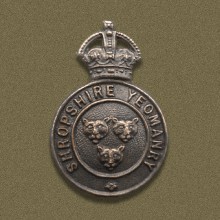
The Shropshire Yeomanry was a yeomanry regiment of the British Army, first raised in 1795, which served as a cavalry and dismounted infantry regiment in the First World War and as a cavalry and an artillery regiment in the Second World War. It was then amalgamated with the Shropshire Royal Horse Artillery.

The Duke of Lancaster's Own Yeomanry (DLOY) was a yeomanry unit of the British Army from 1798 to 1992. Originally raised as part-time cavalry for home defence and internal security, the regiment sent mounted infantry to serve in the Second Boer War. During World War I it carried out mounted duties in Egypt and Palestine and on the Western Front. By 1917 the reserve units at home had become cyclists and the regiment serving on the Western Front joined an infantry battalion, seeing action at the Battle of Passchendaele, against the German Spring Offensive and in the final Allied Hundred Days Offensive. At the beginning of World War II the regiment gave up its horses and formed two regiments of medium artillery, which served in the Middle East, Italy and North West Europe. Postwar it became an armoured unit. Today its lineage is maintained by B Squadron, the Queen's Own Yeomanry.

The North Somerset Yeomanry was a part-time cavalry regiment of the British Army from 1798 to 1967. It maintained order in Somerset in the days before organised police forces, and supplied volunteers to fight in the Second Boer War. It served on the Western Front in the First World War. At the outbreak of the Second World War, it continued to operate in the mounted role and then as a specialist signals unit. Postwar it joined the Royal Armoured Corps and later became infantry. Its lineage today is maintained by 93 Squadron 39 (Skinners) Signal Regiment.
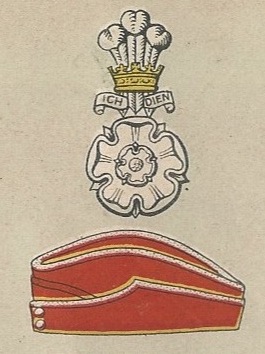
The Yorkshire Hussars was an auxiliary unit of the British Army formed in 1794. The regiment was formed as volunteer cavalry (Yeomanry) in 1794 during the French Revolutionary Wars and served in the Second Boer War and the First World War. It was converted to an armoured role during the Second World War. In 1956, it merged with two other Yorkshire yeomanry regiments to form the Queen's Own Yorkshire Yeomanry. Its lineage is continued today by the Queen's Own Yeomanry.

The Queen's Own Yorkshire Dragoons was a yeomanry regiment of the British Army in existence from 1794 to 1956. It was formed as a volunteer cavalry force in 1794 during the French Revolutionary Wars. Its volunteer companies played an active role with the Imperial Yeomanry in the Second Boer War, but opportunities for mounted action were much more restricted during the First World War and it was temporarily converted into a cycle unit. It remained a cavalry regiment throughout the interwar years, and was the last horsed unit of the British Army to see action, in the Syria–Lebanon Campaign of 1941, finally mechanising the following year. It served as motorised infantry in the North African and Italian campaigns of the Second World War. In 1956, it merged with the Yorkshire Hussars and the East Riding of Yorkshire Yeomanry to form the Queen's Own Yorkshire Yeomanry. Its lineage is continued today by A Squadron, the Queen's Own Yeomanry.
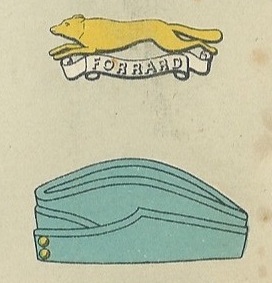
The East Riding of Yorkshire Yeomanry was a unit of the British Army formed in 1902. Units of Yeomanry Cavalry were raised in the East Riding of Yorkshire in the 18th and early 19th centuries at times of national emergency: the Jacobite Rising of 1745, the French Revolutionary Wars and the Napoleonic Wars. These were stood down once each emergency was over. The East Riding of Yorkshire Yeomanry, was established in 1902, and this saw action during the First World War both in the mounted role and as machine gunners.
The Denbighshire Hussars was a Welsh Yeomanry regiment of the British Army formed in 1794. It saw service in the First World War before being converted into a unit of the Royal Artillery. The lineage has been continued by 398 Squadron, Royal Logistic Corps.
The Sussex Yeomanry is a yeomanry regiment of the British Army dating from 1794. It was initially formed when there was a threat of French invasion during the Napoleonic Wars. After being reformed in the Second Boer War, it served in the First World War and the Second World War, when it served in the East African Campaign and the Siege of Tobruk. The lineage is maintained by 1 Field Troop, 579 Field Squadron (EOD), part of 101 (London) Engineer Regiment (Volunteers).

The Westmorland and Cumberland Yeomanry was a Yeomanry Cavalry regiment of the British Army with its origins in 1798. The regiment provided troops for the Imperial Yeomanry during the Second Boer War and served on the Western Front in the First World War, latterly as infantry. The regiment converted to artillery in 1920 and served as such in the early years of the Second World War, before becoming part of the Chindits in Burma. Postwar it served as a gunner regiment until 1971 when the title disappeared.
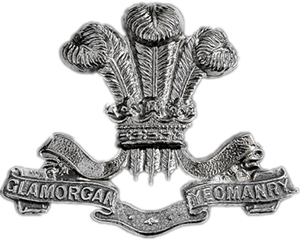
{{Infobox military unit |unit_name=Glamorgan Yeomanry |abbreviation= |image= |caption=Glamorgan Yeomanry cap badge |dates= 1797–1831
1861–1873
1901–present |country = Kingdom of Great Britain (1794–1800)
United Kingdom (1801–Present) |allegiance= |branch= Territorial Army |type=Yeomanry |role= |size= Regiment |command_structure= |equipment= |Past Commanders= |ceremonial_chief= |colonel_of_the_regiment= |notable_commanders=Col Windham Wyndham-Quin |identification_symbol= |identification_symbol_2= |nickname= |patron= |motto= |colors= |march= |mascot= |battles=* Merthyr Rising

The Hampshire Yeomanry was a yeomanry cavalry regiment formed by amalgamating older units raised between 1794 and 1803 during the French Revolutionary Wars. It served in a mounted role in the Second Boer War and World War I, and in the air defence role during and after World War II. The lineage is continued by 295 Battery and 457 Battery, batteries of 106 (Yeomanry) Regiment Royal Artillery, part of the Army Reserve.

The Hertfordshire Yeomanry was a Yeomanry Cavalry regiment of the British Army that could trace its formation to the late 18th century. First seeing mounted service in the Second Boer War and World War I, it subsequently converted to artillery. Three regiments saw service in World War II, one of which was captured at the fall of Singapore. It continued through various postwar amalgamations and its lineage was maintained by 201 Battery, 100th (Yeomanry) Regiment Royal Artillery until that unit was placed in suspended animation in 2014.
The West Somerset Yeomanry was a Yeomanry regiment of the British Army. First raised in 1794, it participated in the Second Boer War and World War I before being converted to an artillery regiment. It served in World War II. Post-war it was gradually reduced in strength until the yeomanry lineage of the successor unit was discontinued on 9 November 1988.
The Surrey Yeomanry was a unit of the British Army first formed as volunteer cavalry in 1794. It was reformed in 1901 and saw varied service in the First World War. During the interwar period, it converted to artillery and during the Second World War one of its regiments distinguished itself during the retreat to Dunkirk, saw action during the Second Battle of El Alamein, and also saw service in Sicily and Italy. Its other regiment served in East Africa, the Siege of Tobruk, and in Iraq and Persia. The regiment's lineage is maintained today by 2 Field Troop, 579 Field Squadron (EOD), part of 101 (London) Engineer Regiment (Volunteers).
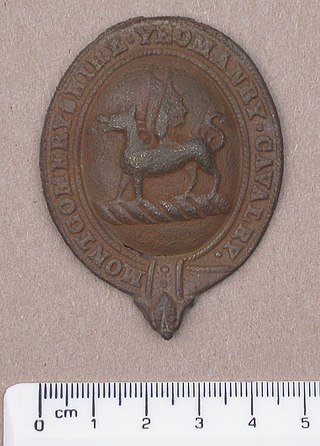
The Montgomeryshire Yeomanry was a Welsh auxiliary unit of the British Army first formed in 1803. It served in home defence and for internal security, including deployments to deal with Chartist disturbances in the 1830s. It provided volunteers to the Imperial Yeomanry during the Second Boer War and formed three regiments for service during World War I. It was broken up and converted to infantry and artillery in 1920.
The Queen's Own Royal Glasgow Yeomanry was a yeomanry regiment of the British Army that can trace their formation back to 1796. It saw action in the Second Boer War, the First World War and the Second World War. It amalgamated with the Lanarkshire Yeomanry and the 1st/2nd Lothians and Border Horse to form the Queen's Own Lowland Yeomanry in 1956. Its lineage was revived by B Squadron, the Scottish Yeomanry in 1992 until that unit was disbanded in 1999.

The Middlesex Yeomanry was a volunteer cavalry regiment of the British Army originally raised in 1797. It saw mounted and dismounted action in the Second Boer War and in the First World War at Gallipoli, Salonika and in Palestine, where one of its officers won a Victoria Cross at the Battle of Buqqar Ridge and the regiment rode into Damascus with 'Lawrence of Arabia'. Between the world wars the regiment was converted to the signals role and it provided communications for armoured formations in the Second World War, including service in minor operations in Iraq, Palestine, Syria and Iran, as well as the Western Desert, Italian and North-West European campaigns. It continued in the postwar Territorial Army and its lineage is maintained today by 31 Signal Squadron, Royal Corps of Signals, which forms part of the Army Reserve.



